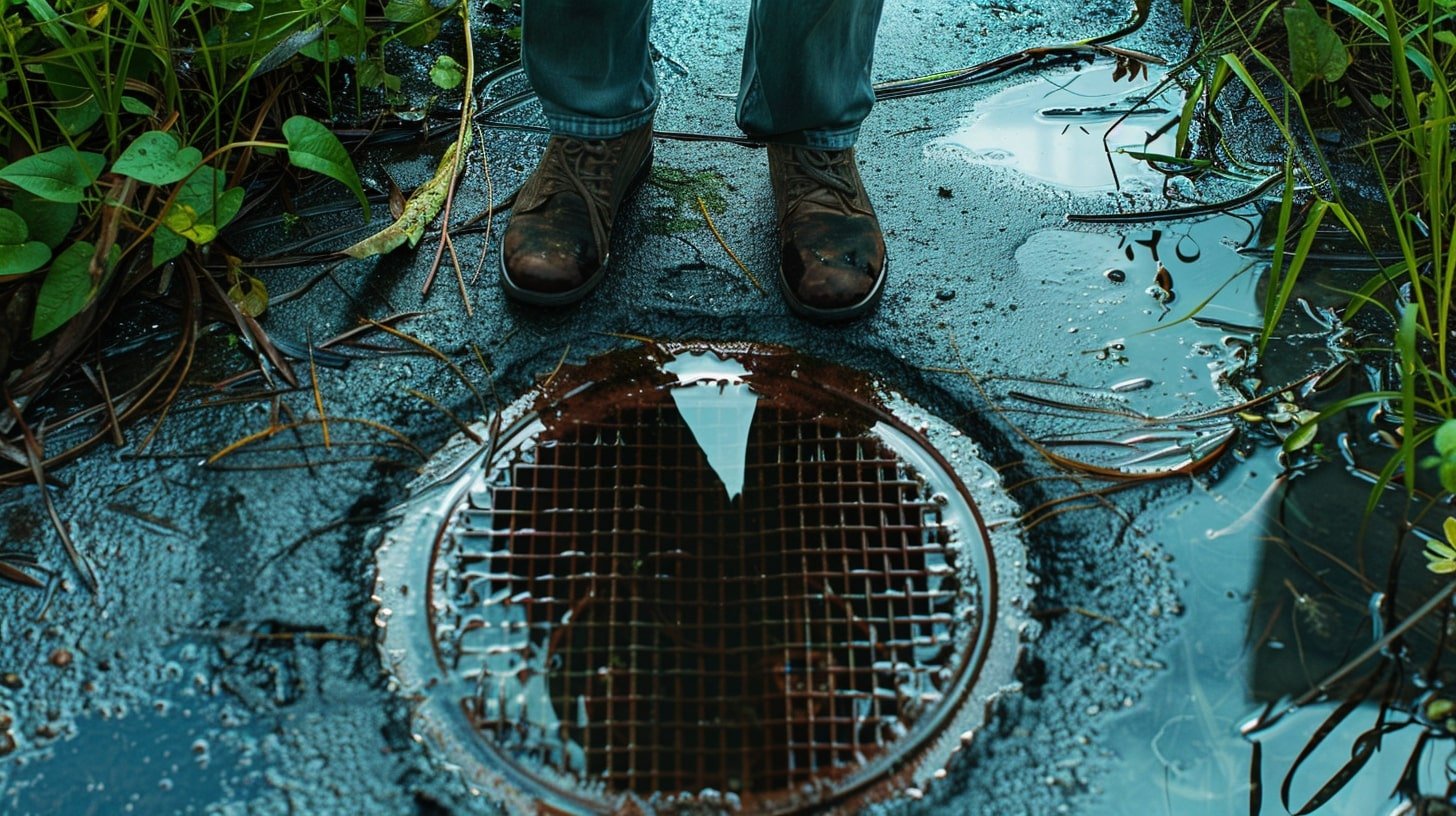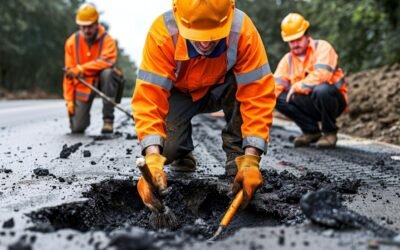Catch basins play a crucial role in managing stormwater in parking lots, helping to prevent flooding and ensuring a safe environment for vehicles and pedestrians alike. Proper maintenance of these systems is essential to ensure they function effectively and last for years. A catch basin collects rainwater and debris, preventing them from flooding the area and entering the sewer system. Over time, debris buildup can lead to clogs and structural damage, making regular inspections and maintenance indispensable.
Table of Contents
Understanding the significance of these systems and adhering to a proactive maintenance regime can save you significant repair costs and extend the lifespan of the catch basin. It is not just about functionality; maintaining your catch basin properly also means complying with environmental regulations that prevent pollutants from entering local waterways. In essence, a little attention goes a long way in maintaining the health of your parking lot’s drainage system.
Understanding Your Catch Basin
Components of a Catch Basin
A catch basin has several key components that work together to drain excess water. The grate or cover at the top traps large debris, while allowing water to flow down. Beneath the grate is a sump, a space where sediment, sand, and smaller particles settle. This setup prevents blockages downstream in the piping that channels the water away from the area. Regularly cleaning this sump is one of the most crucial maintenance activities.
- Grate or Cover:
- Function: The grate or cover sits at the top of the catch basin, acting as the first line of defence against large debris such as leaves, trash, and stones. Its design allows water to pass through while trapping larger objects that could block the system.
- Maintenance Tip: Regularly check and clean the grate to ensure it remains unobstructed, preventing debris from entering the basin and causing blockages.
- Inlet:
- Function: This is the entry point where stormwater flows into the catch basin. It is designed to channel water efficiently into the basin while minimizing the amount of debris that enters.
- Maintenance Tip: Ensure the inlet is free of obstructions and debris to maintain smooth water flow into the catch basin.
- Sump:
- Function: Located beneath the grate, the sump is a deeper section of the catch basin where heavier particles like sediment, sand, and small debris settle. This prevents these materials from travelling further into the drainage system.
- Maintenance Tip: Regularly clean the sump to remove accumulated sediment and debris. This is crucial for maintaining the catch basin’s capacity and functionality.
- Outlet Pipe:
- Function: The outlet pipe allows the filtered water to exit the catch basin and flow into the storm sewer system or detention ponds. It ensures that the water is carried away from the area, reducing the risk of flooding.
- Maintenance Tip: Periodically inspect the outlet pipe for blockages or damage. Use a drain camera if necessary to check for any obstructions or structural issues within the pipe.
- Baffles (if present):
- Function: Some catch basins include baffles, which are barriers that help control the flow of water and trap floating debris and oils. They enhance the basin’s ability to filter pollutants before the water exits.
- Maintenance Tip: Inspect baffles for damage and ensure they are functioning correctly. Clean them regularly to remove trapped materials.
- Sediment Trap:
- Function: Similar to the sump, a sediment trap is specifically designed to capture finer particles and prevent them from entering the outlet pipe. It can be an integral part of the sump or a separate component.
- Maintenance Tip: Clean the sediment trap frequently to prevent buildup, which can reduce the catch basin’s efficiency.
- Frame:
- Function: The frame provides structural support to the grate and holds it securely in place. It also ensures that the catch basin can withstand the weight of traffic passing over it.
- Maintenance Tip: Inspect the frame for any signs of wear, rust, or damage. Ensure it remains securely fastened and capable of supporting the grate under heavy loads.
How Catch Basins Work
The functionality of a catch basin hinges on gravity pulling water towards the lowest point. From the inflow point under the grate, water descends into the catch basin where heavier debris settles at the bottom. Clear water then flows out through an outlet pipe to storm sewers or detention ponds. This mechanism effectively reduces the load on the sewer system and prevents large debris from causing blockages and flooding.
Importance of Regular Catch Basin Cleaning
Ensuring your catch basin is clean is not just about removing visible debris. Sediment buildup can drastically reduce the efficiency of the catch basin and lead to more significant issues. A clogged catch basin can lead to water backup and overflow, causing flooding and erosion in the parking area. Additionally, sediment-filled catch basins can fail to trap pollutants, leading to environmental contamination.
Recognizing the Need for Maintenance
Common Signs of Catch Basin Deterioration
Recognizing the early signs of catch basin failure is crucial for timely maintenance. Common indicators include standing water around the catch basin after a rain event, visible cracks or damage to the concrete structure, and noticeable odours indicating stagnant water. These signs suggest that the catch basin is not functioning correctly and requires immediate attention.
When to Perform Maintenance Checks
Regular maintenance is best scheduled bi-annually or after major storm events. However, the frequency can vary based on the location’s climate, the volume of traffic, and the prevalence of trees and debris. Setting a maintenance schedule following local weather patterns and environmental factors ensures the catch basins are always functioning optimally.
Regular Maintenance Procedures
Cleaning and Clearing Debris
Cleaning out debris like leaves, trash, and sediment from the catch basin should be a routine procedure. This can often be managed with simple tools like scoops and buckets, but may also require a vacuum truck for more extensive cleanups.
Inspecting for Structural Damage
Deterioration can occur in the form of cracks and erosion. Catch basins, being partly underground, are susceptible to such damages due to constant exposure to moisture and environmental elements. Regular visual inspections are recommended to identify these issues early.
Checking for Clogs and Blockages
Blockages not only in the grate but also within the outflow pipes can hinder the functionality of catch basins. Utilizing drain cameras for deeper inspections can help identify and address these issues promptly.
Preventative Measures to Reduce Wear and Tear
Installing guards and filters can significantly reduce the amount of debris entering the catch basin. These measures help maintain the efficiency of the catch basin and decrease the frequency of intensive cleaning sessions.
Step-by-Step Maintenance Guide
Tools and Materials Needed
To maintain your parking lot’s catch basin effectively, you will need a variety of tools and materials. These include protective gloves, safety goggles, a bucket or scoop for debris, a high-pressure water hose for flushing, and possibly a vacuum truck for heavy sediment. For repairs, materials such as concrete patching compounds might also be necessary.
List of essential tools:
- Protective gloves and goggles
- Debris scoop or bucket
- High-pressure water hose
- Vacuum truck (for large or deeply clogged basins)
- Concrete patch (for structural repairs)
Safety Precautions
When performing maintenance on catch basins, prioritizing safety is crucial. Always wear the appropriate personal protective equipment (PPE), including gloves and goggles, to protect against sharp objects and harmful bacteria that can be present. Ensure the area is secured to avoid any accidents involving pedestrians or vehicles. Furthermore, be mindful of hazardous gasses that can accumulate in confined spaces such as catch basins, potentially requiring ventilation or even a confined space permit and professional assistance.
Detailed Maintenance Process
The maintenance of a catch basin involves several detailed steps to ensure it remains clear and operational:
- Inspection: Begin with a thorough inspection to assess the amount of sediment and detect any visible signs of damage or wear.
- Debris Removal: Remove all visible debris from the grate and the sump. This might involve manual scooping or using a vacuum truck for more efficiency.
- Flushing: Use a high-pressure water hose to flush out finer particles and sediment that might not be easily scooped or vacuumed.
- Structural Assessment: Examine the catch basin for any structural damage such as cracks or crumbling and perform necessary repairs using appropriate materials.
- Preventative Measures: Consider installing guards or filters to prevent future debris accumulation. Regularly check and replace these as necessary.
Troubleshooting Common Issues
Addressing Overflow Problems
Overflow issues in catch basins can lead to flooding and property damage. To address this, first ensure that the outlet pipes are not blocked and that water can freely flow. If blockages are found within the basin or pipes, remove them promptly. Regular maintenance checks can prevent most overflow issues before they become problematic.
Repairing Minor Damages
Minor damage such as small cracks or broken edges can often be fixed with a simple concrete patch. It is crucial to address these repairs quickly to prevent them from worsening, which could lead to more significant structural failures or safety hazards.
Professional Help or DIY?
While many aspects of catch basin maintenance can be handled through DIY efforts, complex issues such as deep pipe blockages or significant structural damage might require professional intervention. Hiring experts can ensure the job is done safely and effectively, especially when dealing with larger or more complex drainage systems.
Ensuring Compliance with Regulations
Understanding Local Standards
Compliance with local environmental regulations is imperative when maintaining parking lot catch basins. Each municipality in Canada may have specific standards regarding water quality and discharge that must be adhered to to avoid fines and ensure public safety. For instance, guidelines could pertain to the permissible level of pollutants in the runoff or the structural integrity of the containment system.
It is advisable to familiarize yourself with these standards by consulting local regulatory bodies or environmental protection agencies. This knowledge not only ensures compliance but also guides the maintenance practices and materials used.
Importance of Compliance
Maintaining compliance with local regulations is not just a legal obligation but also a commitment to environmental stewardship and community safety. Properly maintained catch basins help prevent pollutants from entering waterways, thus protecting aquatic life and maintaining the quality of water bodies that communities rely upon for recreation and water supply.
The Cost of Maintenance
Budgeting for Regular Maintenance
Regular maintenance of catch basins is a cost-effective strategy compared to the expenses associated with emergency repairs following neglect. Budgeting for bi-annual cleanings and inspections should be part of your operational planning. Allocating funds regularly helps manage these costs predictably and avoids the financial strain of unforeseen expenses.
Long-term Savings vs. Immediate Costs
While the initial costs of setting up a routine maintenance program for catch basins can seem high, the long-term savings are significant. Regular maintenance reduces the risk of major repairs, extends the lifespan of the catch basin, and ensures compliance with regulatory standards, which can be expensive if violated. Additionally, well-maintained catch basins enhance the overall property value and its appeal.
Key Takeaway: Effective budgeting and understanding the long-term financial benefits of regular catch basin maintenance can lead to significant cost savings and operational efficiencies.
Hiring Professionals for Maintenance
When to Hire Professionals
While routine inspections and minor cleaning can often be handled in-house, there are circumstances where hiring professional maintenance services becomes necessary. This is particularly true for extensive damages, deep structural issues, or when specialized equipment like CCTV drain cameras or vacuum trucks are required. Professional services ensure that the maintenance is thoroughly and safely conducted, adhering to industry standards.
What to Look for in a Service Provider
When choosing a professional service provider for catch basin maintenance, consider their expertise, the quality of the equipment they use, their understanding of local regulations, and their record of reliability and customer satisfaction. It’s also beneficial to select providers with environmental certifications or those who demonstrate a commitment to sustainable practices.
Key Takeaway: Employing professional maintenance services can provide peace of mind that your catch basins are managed efficiently and compliantly, leveraging expert skills and advanced equipment.
Each section of this comprehensive guide addresses critical aspects of maintaining parking lot catch basins, ensuring they operate efficiently, comply with regulations, and cost-effectively serve their intended purpose. This structured approach helps parking lot owners and managers prevent serious issues before they arise and contributes to safer and more sustainable community infrastructure.
Why You Should Choose City Wide for Your Catch Basin Maintenance
Choose City Wide for your catch basin maintenance to benefit from over 30 years of industry expertise, environmentally friendly practices, and a wide range of specialized services tailored to your needs. Our family-owned, locally-operated business ensures reliable, high-quality service at competitive prices. With a trained and experienced team, we guarantee compliance with local regulations, enhancing your property’s safety and longevity. Contact City Wide today to experience top-notch maintenance that protects your investment and the environment.
- Learn more about City Wide’s Catch Basin Services today!
Advanced Tips for Long-Term Maintenance
Innovative Tools and Practices
To take parking lot catch basin maintenance to the next level, consider integrating innovative tools and practices into your routine. Technologies such as automated sensors can monitor water levels and sediment build-up, alerting maintenance teams to potential problems before they become critical. Additionally, implementing a GIS (Geographical Information System) can help track the condition and maintenance history of multiple catch basins across a large parking lot or multiple properties.
Training for In-house Maintenance Teams
Empowering your maintenance team with specialized training in catch basin upkeep can dramatically improve the efficiency and effectiveness of your maintenance strategy. This training should cover not only the basics of cleaning and inspection but also more advanced techniques such as minor repairs and compliance adherence. Offering periodic refresher courses will also keep your team up-to-date with the latest best practices and regulatory changes.
Conclusion
Effective maintenance of parking lot catch basins is not just a matter of compliance or functionality; it’s about sustainability and proactive property management. By adhering to a regular maintenance schedule, utilizing the right tools and knowledge, and possibly engaging professional services when necessary, property managers can ensure that their catch basins efficiently manage stormwater, minimize environmental impact, and maintain their property’s value and safety.
We hope this guide serves not just as a resource for maintaining your catch basins but as a blueprint for best practices in facility management. Remember, the cost of preventative maintenance far outweighs the expense and inconvenience of emergency repairs.
FAQs
What is the best time of year to conduct maintenance on catch basins?
The best time of year for maintaining catch basins in parking lots is generally in the early spring and late fall. These periods directly precede and follow the heavier rain seasons, allowing for cleanup of debris accumulated over winter and ensuring the system is clear before winter freezes set in, potentially causing blockages and damage.
How often should catch basin filters be replaced?
The frequency of replacing catch basin filters can vary depending on the volume of traffic and the typical amount of debris in the area. As a general guideline, it’s advisable to check the filters during regular bi-annual maintenance and replace them as needed, or at least once a year if there is frequent clogging.
Can landscaping affect catch basin efficiency?
Yes, landscaping can significantly impact the efficiency of catch basins. Trees and plants near catch basins can lead to increased leaves and debris entering the system, which can cause blockages. Conversely, strategic landscaping with appropriate ground cover can reduce soil erosion and the amount of sediment entering the catch basins. It’s important to carefully plan any landscaping near catch basins to balance aesthetics with functionality.
What are the environmental impacts of poorly maintained catch basins?
Poorly maintained catch basins can lead to several environmental issues, including increased pollution and sediment entering local waterways, which can harm aquatic life and water quality. Additionally, overflow and improper filtration can contribute to localized flooding and erosion, disturbing natural habitats and potentially leading to more severe water management problems.
How can technology help in managing catch basin maintenance?
Technology can greatly enhance the efficiency and effectiveness of maintaining catch basins. Automated sensors and smart monitoring systems can provide real-time data on water levels and sediment build-up, alerting maintenance crews to potential issues before they become critical. Additionally, the use of GIS systems can help track and schedule maintenance across multiple catch basins efficiently. These technologies not only help in routine maintenance but can also provide valuable data for improving stormwater management practices overall.








